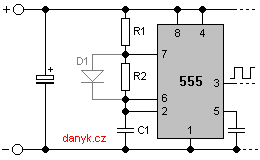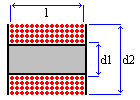براي اطلاع از آپيدت شدن وبلاگ در خبرنامه وبلاگ عضو شويد تا جديدترين مطالب به ايميل شما ارسال شود
|
|
Electrical engineering online calculator
This online calculator allows you to perform a variety of well known and lesser known calculation of electrical engineering. Contains the calculations from the article, the formula and many more. The decimal place is necessary to use a period.
The calculator is in test operation. If someone does not work, turn on your JavaScript. If it does not work then write me. If something calculated wrong, write me.:) Gradually, I'll add more here.
Instructions:
Blue entries are input-type value.
Red items are output-there is in them a result.
Green items are bi-directional. For the calculations of green items, fill in all the boxes except one, which will be calculated (unless stated otherwise).
Finally, press "calculate". The check box to delete, press "delete".
1. The resistance of the wires
The relationship between the resistance of the wires, its cross-section (diameter) and its length. Enter the metal and any 2 values, the third will be dopočítána.
-Do you have a špuli wire. You don't want it all unravel because of the findings of its length. Here you can find out the length of the wire by its resistance (ohm) and its cross-section or diameter.
-You can also determine how large the resistance of the coil will have a certain length, or leadership and the cross-section (diameter).
-You can also specify the minimum cross-section (diameter) wires, if the management or winding the length must not exceed a certain resistance.
2. Diameter-wire cross-section
The conversion from the diameter of the conductors on the back and slicer
3. the Power transformer
-An indicative performance detection of the transformer (230V, 50 Hz) according to the resistance of the primal. Just a lot of really applies indicative:).
-Determine the performance of the transformer (EI core, 50 Hz) according to the cross-section of the middle column. (The transformer with high induction and temperature class may undervalue.)
4. The weight of the conductors
The relationship between the weight of the wire cross-section (diameter) wire and its length. Enter the metal and any 2 values, the third will be dopočítána.
5. measurement of the capacity of the "network"
According to the current that flows when the capacitor voltage 230V 50 Hz, calculates the capacity.
6. measurement of inductance "network"
According to the stream that flows tlumivkou (coil) at a voltage of 230V 50 Hz, calculates the inductance (method is suitable only for iron inductance is large enough to prevent their destruction, or the excavation, the glut of circuit breakers).
7. The loss of ICE vs. wavelength
The relationship between the loss of voltage on the diode LED and its wavelength (indicative)
8. The intensity of the light flow
The conversion of light intensity in kanedlách (cd) to the luminous flux in lumens (lm) and back. Suitable for LEDs and other light sources. Thanks to him, you can specify the specific lighting performance and light efficiency and compare light sources with different angle of radiation. Alpha is the angle of the light cone.
9. short-term overloading or winding
-Calculating how many ° c is heated wire overloaded a particular shock for some time.
-Calculate how long can overload the wire shock even if we know the maximum temperature rise, which is the difference of the initial temperature and the maximum allowed temperature of the leadership or the transformer.
10. Thomson relation (L, C, f)
Thomson relationship-the relationship between the capacity of the capacitor, inductance coil and resonant frequencies in the resonant LC circuit. From any two of the values, you can calculate the third.
11. Charging and discharging a capacitor
(Discharging) capacitor-charging constant current relationship:
C. U = t I
[Farad. Volt = second. Ampere]
Enter any of the three variables, the fourth will be dopočítána.
12. Inductance and SS voltage
Inductance connected to voltage relationship:
L I = t U
[Henry. Ampere = second. Volt]
Enter any of the three variables, the fourth will be dopočítána.
13. The capacitor in the circuit
The relationship of capacity, frequency, voltage and current. Enter any of the three variables, the fourth will be dopočítána.
14. Inductance in the circuit
The relationship of the inductance, frequency, voltage and current. Enter any of the three variables, the fourth will be dopočítána.
15. The calculation of the network transformer
The calculation of the network transformer and classic EI, EE, or plates. Frequency 50 Hz. (on the toroidal, UI and LL of the transformer does not apply)
16. the Rectifier output voltage and the ripple
This calculation allows the exact (not aproximovaný) the calculation of the output parameters of the rectifier. Finds the maximum and minimum voltage, their difference (ripple) and relative ripple. Allows you to choose between one-way and two-way (můstkovým) direct current. You can choose between the load with a constant stream of collection (e.g. stabiliser) or resistive load. It is possible to specify a shrinkage of the diode or bridge. For a one-way rectifier (1 led) is approx. 0 .8V. For the bridge is the loss of approximately 1, 6V, because always apply 2 diodes. (For help with the calculation of the resistance zátěžě thank Goheecovi.)
17. The resistor for LED
Calculation of the předřadného of resistance for the diode LED. Enter the loss of diodes, the voltage and the current (less than the max current). The supply voltage must always be greater than the loss.
18. Ohm's law
To not add:). Enter the 2 variables, the third will be dopočítána.
19. "Watt's" law
You can choose between direct current (P = U. I) and alternating current (P = U. (I). COS PHI). The missing variable will be dopočítána.
20. the Input resistance of the load, the loss in the resistance/conductors
-Detects the loss of and loss of conductors/resistance when a known stream or designate a stream, in which experiencing the loss. -Identify certain absorbed current and input power resistive loads (the loss of resistance) is connected to a known voltage or designate the necessary tension to achieve the losses and a flowing stream. -Detects a resistance that the appliance must take in order to remove the voltage from the power. It also displays its current consumption. -Counts, what resistance the appliance (conductor) must be given to the stream to the loss. At the same time displays its voltage drop. -According to the voltage and current will determine resistance and wattage of the appliances.
Enter two values, the remaining pair will be dopočítána.
21. RC-circuit Discharge the capacitor through a resistor.
The capacitor C is charged on the initial voltage U1. Despite the resistance R is aggression on the end voltage U2 for time t. The relationship between the resistance, capacity, the initial voltage, the discharge end voltage and time. Type 4, the fifth value will be dopočítána.
22. RC-circuit time constant (tau)
The relationship between the resistance and capacitor on the RC article and its time constant. Enter 2 values, the third will be dopočítána. The time constant is the time at which the voltage on the capacitor reduces e-times (2, 718x).
23. Energy in the capacitor
Calculation of the energy in the capacitor. You can choose between versions with total energy and relaxed energy (the energy that is released when an incomplete discharge of the capacitor on the residual voltage). The calculation is suitable for example. When you design a stroboskopů, fotoblesků, coilgunů (cívkových pistol), etc. Enter all the details in addition to the one that will be were still unaccounted for.
24. the current density in the wires
The form allows you to calculate with a current density of wires, cables or the windings of the transformer.
-The calculation of the parameters of the wires (diameter and cross-section) under the famous current and selected current density
-Calculation of current density by a known stream and wires (we know the diameter or cross-section)
-Calculation of the max current, max. current density and diameter or cross-section of conductors used.
Enter two values, the remaining two will be dopočítány.
25. the frequency and duty cycle oscillator with 555
The calculation of the frequency of the oscillator and weaves (astabilního heeling circuit) with the 555 timer (NE555, CA555, CM555, SA555, TS555 ...). Enter the values of the resistors R1, R2 and capacitor C1 (see picture). Choose whether the circuit is used in diode D1 (lets get střídu under 50%).

26. The calculation of the SS electromagnet
The calculation of the DC electromagnet coil. It finds a suitable wire diameter and number of coils for solenoid is powered by the voltage with winding on the kostřičce of known dimensions and selected current density in the conductor. Specifies the length of the wire, the resistance of the windings and absorbed by the SS.
Factor (factor) q is the ratio of the performance of the windings of the total cross-sectional area of copper (pure wire cross section times the number of coils) to the desktop window winding.

zpět na úvodní stránku
:: بازدید از این مطلب : 1751
|
امتیاز مطلب :
|
تعداد امتیازدهندگان :
|
مجموع امتیاز :
|
|
|

